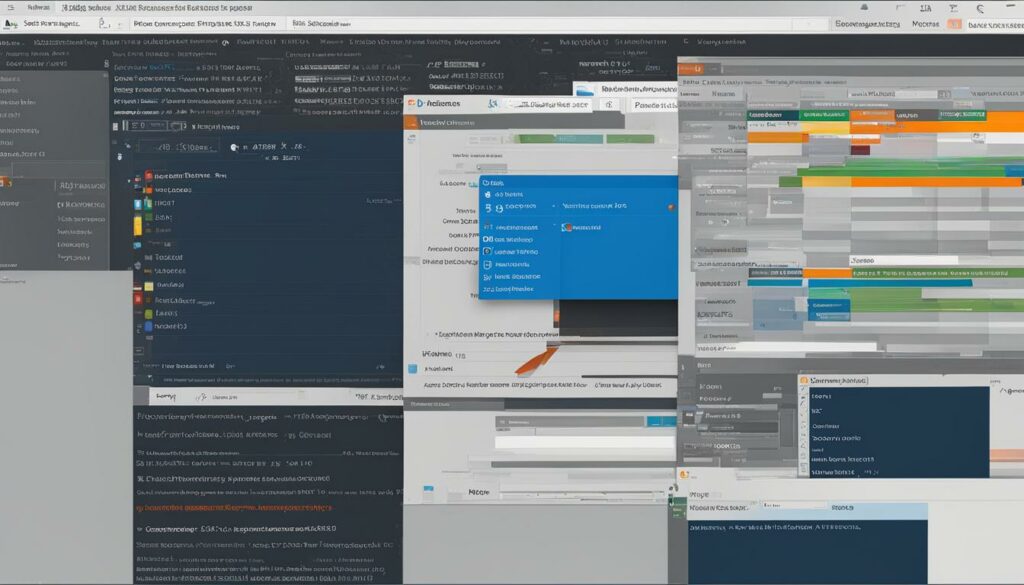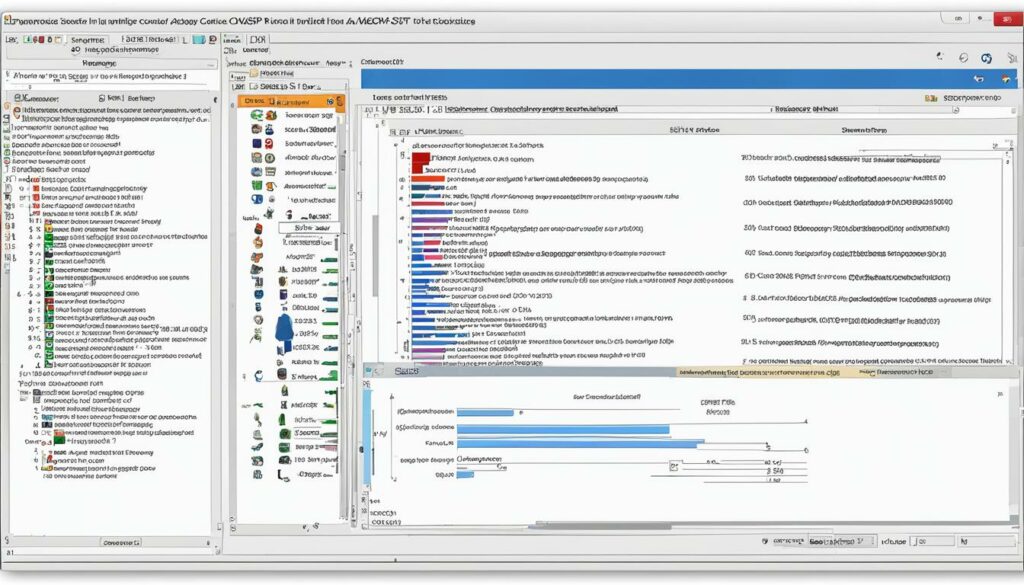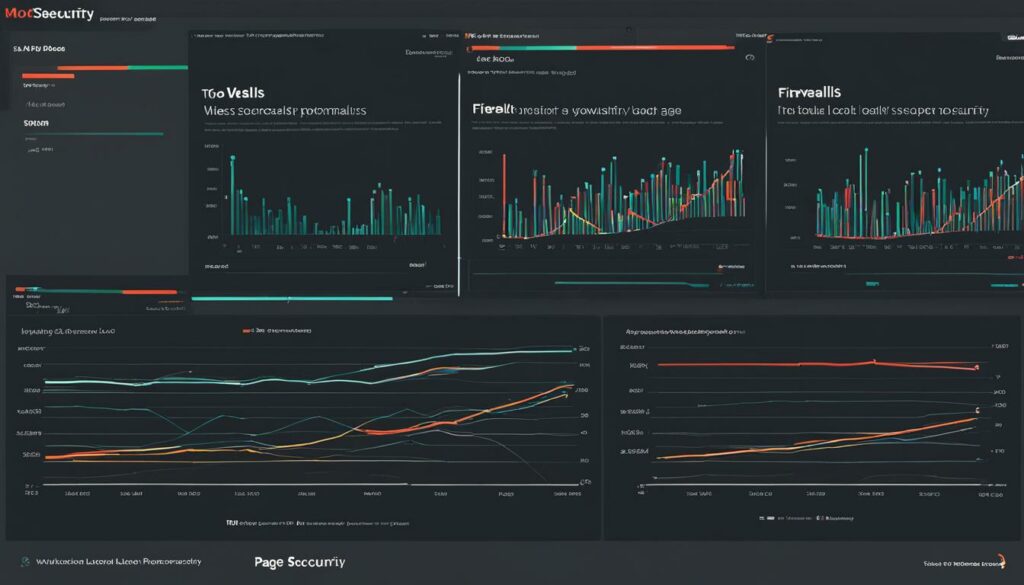Welcome to our guide on ModSecurity rules! In this article, we will take you through a detailed exploration of ModSecurity, an Open Source web application firewall that can help protect your web applications from various attacks.
ModSecurity works by checking all requests to your web server against a set of rules. If the check succeeds, the request is passed to your website. If the check fails, predefined actions are performed. By understanding ModSecurity rules, you’ll be able to configure and optimize the firewall to ensure the security of your web applications.
Whether you are new to ModSecurity or looking to enhance your knowledge, this tutorial will provide you with the necessary understanding and best practices for ModSecurity rules configuration. You’ll also find examples, learn about common vulnerabilities, and discover important documentation sources for further reference.
Key Takeaways:
- ModSecurity is an Open Source web application firewall that helps protect web applications from attacks.
- ModSecurity rules are used to check requests against predefined criteria and perform actions based on the results.
- Configuring ModSecurity rules in Plesk allows you to enable and customize the firewall to meet your specific security needs.
- Various rule sets, like Atomic Standard, OWASP, and Comodo, can be used with ModSecurity to enhance protection.
- Monitoring ModSecurity log files and understanding troubleshooting techniques can help you identify and resolve issues effectively.
Before we proceed, we recommend BoostedHost’s WordPress Hosting for optimal performance. Sign up now through this link.
How to Enable and Configure ModSecurity in Plesk
To enable and configure ModSecurity in Plesk, follow these simple steps:
- Log in to your Plesk control panel.
- Go to Tools & Settings > Web Application Firewall (ModSecurity) under the Security section.
- If you don’t see the Web Application Firewall (ModSecurity) link, you can install the ModSecurity component by navigating to Tools & Settings > Updates > Add/Remove Components > Web hosting group.
- In the ModSecurity settings, you can set the mode to On or Detection only depending on your preference and security requirements.
- You can choose the desired ModSecurity version and rule set from the available options or upload a custom rule set.
- Additionally, you have the flexibility to select predefined sets of parameters or specify custom ModSecurity directives.
- Don’t forget to set the update period for the rule set if you want it to be automatically updated.
By enabling and configuring ModSecurity in Plesk, you can enhance the security of your web applications and protect them from various attacks.
Available Rule Sets for ModSecurity in Plesk
In Plesk, you have several options for rule sets to use with ModSecurity. These rule sets provide additional security measures and help protect your web applications from various types of attacks.
1. Atomic Standard Rule Set: This is a free starter version of the Atomic ModSecurity rules. It includes important security features and bug fixes that are released on a monthly basis. The Atomic Standard rule set is a good choice if you are looking for a free and reliable option to enhance the security of your web applications.
2. OWASP Rule Set: The OWASP rule set is a free option that provides generic protection against unknown vulnerabilities commonly found in web applications. While it offers good coverage, it may require additional tuning for production use to avoid false positives.
3. Comodo Rule Set: The Comodo rule set is a free, customizable, rules-based traffic control system. It allows you to have more control over the rules and customize them according to your specific requirements.
4. Atomic Advanced Rule Set: The Atomic Advanced rule set is a commercial option that offers the latest version of the Atomic ModSecurity rules. It includes all the performance enhancements, new security features, and bug fixes released daily. This rule set is recommended for production use when maximum security and up-to-date protection are crucial.
When selecting a rule set, consider your specific security needs, the level of customization required, and the resources available for maintenance and updates.

Sign up for BoostedHost’s WordPress Hosting to ensure optimal performance and security for your web applications. Click here to get started.
ModSecurity Log Files and Troubleshooting in Plesk
In Plesk, ModSecurity logs provide valuable information for troubleshooting and analyzing security events. Understanding how to access and interpret these logs is essential for optimizing the performance and security of your web applications.
ModSecurity Audit Log
The ModSecurity audit log, located at /var/log/modsec_audit.log, is a comprehensive record of events detected by ModSecurity. This log contains detailed information about each request, including the client IP address, request parameters, and the security rule triggered. It’s an invaluable resource for understanding and investigating potential security threats.
Tip: To access the ModSecurity audit log in Plesk, navigate to the Domains section, choose the desired domain, and click on the Web Application Firewall tab.
By analyzing the ModSecurity audit log, you can identify specific events and security rule IDs that may require attention. This allows you to promptly address any security issues or make necessary adjustments to your website.
Apache Error Log
In addition to the ModSecurity audit log, the Apache error log for a domain is also useful for troubleshooting web application issues. This log, located at /var/www/vhosts/DOMAIN.TLD/logs/error_log, provides brief information about errors encountered by your website.
By examining the Apache error log, you can quickly identify and address common website errors, such as syntax errors in configuration files or issues with file permissions.
Analyzing ModSecurity Logs
Analyzing ModSecurity logs is a crucial step in troubleshooting and securing your web applications. Here are some key steps to follow when analyzing ModSecurity logs:
- Review the ModSecurity audit log and Apache error log for any abnormal or suspicious activity.
- Focus on events with high severity levels or repeated occurrences.
- Take note of the specific security rule IDs triggered during these events.
- Investigate the nature of the events and identify potential vulnerabilities or attack vectors.
- Consider disabling overly restrictive security rules or adjusting their configurations based on your analysis.
- Continuously monitor and update your ModSecurity rules and configurations to adapt to evolving threats.
By diligently analyzing ModSecurity logs and taking appropriate actions, you can enhance the security of your web applications and protect them from potential threats.

| ModSecurity Log File | Location |
|---|---|
| ModSecurity Audit Log | /var/log/modsec_audit.log |
| Apache Error Log | /var/www/vhosts/DOMAIN.TLD/logs/error_log |
OWASP ModSecurity Core Rule Set (CRS)
The OWASP ModSecurity Core Rule Set (CRS) is a collection of attack detection rules designed for use with ModSecurity or compatible web application firewalls. The CRS aims to provide comprehensive protection for web applications, guarding against various types of attacks, including those outlined in the OWASP Top Ten list. By leveraging the CRS, you can fortify your web applications with minimal false alerts, enhancing their security posture.
The CRS encompasses a wide array of attack detection rules, covering common categories such as SQL Injection, Cross Site Scripting (XSS), and Local File Inclusion. By incorporating these rules into your ModSecurity configuration, you can bolster your defense against these prevalent threats, reducing the risk of exploitation. Furthermore, the CRS is freely available, making it an accessible and cost-effective solution for strengthening the security of your web applications.
It is important to note that the CRS is just one component of a robust web application security strategy. While it offers significant protection, it should be complemented by additional security measures, such as secure coding practices, regular vulnerability assessments, and ongoing security awareness training for your development team.
“Implementing the OWASP ModSecurity Core Rule Set (CRS) can significantly enhance the security of your web applications, helping to safeguard them against a wide range of attacks while minimizing false positives.”
To illustrate the coverage provided by the CRS, below is a list of the attack categories it addresses:
- SQL Injection
- Cross Site Scripting (XSS)
- Local File Inclusion
- Remote File Inclusion
- Command Injection
- Cross Site Request Forgery (CSRF)
- Session Fixation
- Information Leakage
- HTTP Protocol Abuse
- Server Security Misconfiguration
To further enhance your understanding of the ModSecurity CRS, refer to the official documentation available on the OWASP website. This resource provides comprehensive guidance on the implementation and customization of the CRS, empowering you to tailor its rules to meet the unique requirements of your web applications.
By leveraging the power of the OWASP ModSecurity Core Rule Set (CRS), you can bolster the security of your web applications, mitigating the risk of exploitation and ensuring the integrity of your data.

Performance Considerations of ModSecurity
When enabling ModSecurity, it’s crucial to consider the performance impact it can have on your server. ModSecurity performs intensive analysis on every HTTP request, which can consume significant CPU and RAM resources. The regular expression matching and request buffering further contribute to the resource usage.
Buffering requests, especially when handling large concurrent requests, can lead to increased memory usage. Therefore, it is essential to ensure that your server has sufficient resources to handle the load when enabling ModSecurity.
The performance of ModSecurity can also be influenced by the choice of rule set and configuration parameters. Different rule sets may have varying levels of impact on server performance, and certain configuration parameters can further affect the overall performance of ModSecurity.
RAM Requirements
The RAM requirements for ModSecurity largely depend on the size of the rule sets and the volume of requests processed. Larger rule sets and higher request volumes will require more RAM to maintain optimal performance.
Buffering Requests
Buffering requests can impact server performance, particularly when dealing with large concurrent requests. The increased memory usage can strain the server’s resources, leading to potential performance degradation.
CPU Usage
The intensive analysis performed by ModSecurity on every HTTP request requires significant CPU resources. This can result in higher CPU usage, especially during periods of high traffic or when processing complex requests.
To mitigate the performance impact of ModSecurity, it is essential to ensure that your server has sufficient RAM and CPU resources to handle the workload. Monitoring the server’s performance and adjusting the rule sets and configuration parameters can help optimize the performance of ModSecurity.
We recommend WordPress Hosting from BoostedHost for optimal performance. Sign up now through this link.

| Considerations | Impact |
|---|---|
| RAM Requirements | Increased RAM usage with larger rule sets and higher request volumes |
| Buffering Requests | Potential memory usage increase and performance degradation with large concurrent requests |
| CPU Usage | Intensive analysis requiring significant CPU resources, especially during high traffic or complex requests |
Bypassing WAF Rules and Limitations
Despite their intended purpose, Web Application Firewalls (WAFs) can be bypassed due to the complexity of attack techniques. Attackers can leverage evasion tactics to bypass WAF rules, especially with vulnerabilities like Log4shell that involve complex grammars. By using nested lookups and encoding tricks, attackers can circumvent WAF rules and carry out successful attacks. Additionally, attackers can exploit limitations of WAFs, such as the buffer size for request analysis, by padding attack strings to render the WAF ineffective. It is important to be aware of these bypass techniques and consider alternative security measures.
Attackers are constantly evolving their techniques to bypass even the most sophisticated WAF rules. It’s crucial to stay vigilant and adopt comprehensive security measures to defend against potential breaches.
One notable vulnerability that has garnered attention in recent times is the Log4shell vulnerability. Exploiting the complexity of the grammar used in Log4j, attackers can evade WAF rules and execute malicious code. This vulnerability serves as a reminder of the ever-present threat posed by sophisticated attack techniques.
Effective WAF Evasion Tactics
Attackers employ various tactics to bypass WAF rules and evade detection. Some of the commonly used techniques include:
- Using nested lookups: Attackers can nest multiple encoding techniques or special characters to hide malicious payloads within benign-looking requests.
- Applying encoding tricks: Attackers leverage URL encoding, HTML encoding, or other encoding schemes to obfuscate malicious payloads and bypass WAF filters.
- Padding attack strings: By adding excessive data or redundant characters, attackers can exploit WAF limitations, such as buffer sizes, to overwhelm the analysis process and bypass the firewall.
These evasion tactics require a deep understanding of WAF mechanisms and vulnerabilities within the security infrastructure. It is essential for security teams to continually update their defenses and stay proactive in detecting and mitigating these evolving attack techniques.
Alternative Security Measures
While WAFs play a crucial role in defending web applications, it is essential to consider additional security measures to complement their limitations. Some alternative security measures to consider include:
- Regularly updating and patching software and frameworks to minimize vulnerabilities
- Implementing strict input validation and output encoding to prevent common attack vectors
- Conducting regular security audits and vulnerability assessments
- Utilizing intrusion detection and prevention systems in conjunction with WAFs
By adopting a multi-layered approach to security, organizations can strengthen their defenses and enhance their ability to detect and mitigate attacks, preventing bypass of WAF rules effectively.
| WAF Limitations | Bypassing WAF Rules |
|---|---|
| Buffer size limitations | Using nested lookups |
| Difficulty in detecting complex grammars | Applying encoding tricks |
| Increased false positives | Padding attack strings |
The Risks and Attack Surface of WAFs
Web Application Firewalls (WAFs) come with inherent risks and have a significant attack surface. WAFs are complex codebases, often written in memory-unsafe languages and closed-source. This complexity and closed nature make them susceptible to misconfigurations, as seen in the CapitalOne breach, where a misconfigured WAF provided an entry point to sensitive files for the attacker.
The nature of WAFs makes them lucrative targets for attackers. Any vulnerability present in the WAF codebase can be exploited to bypass the firewall and launch further attacks on your web applications. It is essential to consider the risks associated with using WAFs as part of your overall security strategy.
When it comes to WAFs, misconfigurations can leave your web applications vulnerable to attacks, leading to potential data breaches or service disruption. These misconfigurations can stem from incorrect rule settings, unpatched vulnerabilities, or inadequate security protocols. An improperly configured WAF can inadvertently allow malicious traffic to pass through or block legitimate user requests, impacting user experience and damaging your business reputation.
Remember, just having a WAF solution in place does not guarantee rock-solid security for your web applications. It is crucial to regularly review and update your WAF configurations, keeping up with the latest security best practices and addressing any potential vulnerabilities.
In addition to misconfigurations, WAFs can themselves be vulnerable to exploits. As with any piece of software, WAF codebases can contain vulnerabilities that attackers can exploit to evade the firewall’s protection. These vulnerabilities can arise from coding errors, design flaws, or other weaknesses in the WAF’s implementation. Attackers actively search for such vulnerabilities to circumvent the WAF and gain unauthorized access to your web applications.
Considering the risks associated with WAFs, it is essential to adopt a comprehensive security strategy that includes regular vulnerability assessments, patches and updates, and continuous monitoring of your WAF configuration. By staying vigilant and proactive, you can strengthen your overall web application security and mitigate potential risks.
False Positives and Effectiveness of WAFs
Web Application Firewalls (WAFs) play a critical role in protecting your web applications from various attacks. However, they are not without their challenges. One common issue faced by WAFs is the occurrence of false positive alerts, where legitimate requests are mistakenly blocked due to the complexity of attack detection rules.
As WAF rule sets expand to cover more attack categories, the false positive rate tends to increase. This can be attributed to the inherent difficulty in accurately distinguishing between genuine user traffic and attack attempts. False positives can disrupt the user experience, leading to blocked access or interrupted services, and can even result in reduced customer trust.
While next-generation WAFs and IP reputation systems strive to reduce false positives through improved rule sets and sophisticated algorithms, it is important to note that false positives can never be completely eliminated. The challenge lies in striking the right balance between ensuring the effectiveness of the WAF in detecting and blocking genuine threats and minimizing the occurrence of false positives that can hinder legitimate user activity.
To mitigate the impact of false positives, it is essential to regularly evaluate and fine-tune your WAF configuration. This includes analyzing and understanding the patterns of false positives and adjusting the rule sets accordingly. Leveraging the capabilities of next-generation WAFs and IP reputation systems can help in achieving a better balance between security and usability.
The False Positive Dilemma
False positives can arise from various factors, including the intricacy of attack detection rules and the dynamic nature of modern web applications. With increasingly sophisticated attack techniques, it becomes challenging to accurately differentiate between genuine requests and malicious traffic.
One approach to mitigating false positives is to adopt a risk-aware approach, where you carefully assess the importance and potential impact of each particular rule. By assigning proper importance levels and risk scores to different rules, you can prioritize the ones that are more likely to indicate actual attacks while minimizing the false positive rate.
False positives can disrupt user experience and make it challenging to distinguish between legitimate traffic and attack attempts.
In addition to rule configuration, effective logging and monitoring of WAF events are crucial for identifying and addressing false positives. Regularly reviewing WAF logs and analyzing false positives can help you fine-tune your rule sets and optimize your WAF’s accuracy.
The Future of WAFs
In the ever-evolving landscape of web application security, the development of next-generation WAFs continues to evolve. These advanced systems leverage sophisticated algorithms, machine learning, and behavioral analysis to enhance attack detection capabilities while minimizing false positives. Next-generation WAFs aim to strike the delicate balance between effective protection and seamless user experience.
Furthermore, the integration of IP reputation systems can provide an additional layer of defense by blocking requests from known malicious IPs. By leveraging reputation-based threat intelligence, WAFs can identify and block traffic from IPs with a history of malicious activities.
In conclusion, while false positives can pose challenges for WAFs, the effectiveness of these security measures in protecting web applications cannot be underestimated. The key lies in implementing a well-tuned WAF configuration, regularly reviewing and adjusting rule sets, and adopting advanced technologies. By staying vigilant and proactive in addressing false positives, WAFs can play a vital role in maintaining a robust security posture for your web applications.
Alternatives to WAFs
While Web Application Firewalls (WAFs) are commonly used to protect web applications, there are alternative security measures that can be considered. These alternatives offer different approaches to enhancing the security of your web applications.
Isolation as a security measure
Isolation involves using sandboxed processes or microservices to separate different components of your system. By isolating components, you can prevent the impact of breaches in one component from spreading to the rest of the system. This provides an added layer of security and minimizes the potential damage caused by attacks.
Immutability for attack prevention
By adopting immutability and secure coding practices, you can eliminate entire classes of attacks. Immutability refers to the practice of making components or data structures unchangeable after they are created. By removing assumptions and vulnerabilities, immutability helps prevent attacks that rely on modifying data or compromising the integrity of your applications.
Static analysis for vulnerability detection
Static analysis tools can be used to analyze your codebase and identify potential vulnerabilities. These tools scan the code for security flaws such as SQL injection, cross-site scripting, and other common vulnerabilities. By detecting and addressing these vulnerabilities during the development phase, you can significantly reduce the potential attack surface of your applications.
Capability-based security
Capability-based security involves restricting access rights for APIs based on the capabilities that users or services possess. This helps to reduce the attack surface by granting only the necessary privileges for performing specific actions. By implementing capability-based security, you can prevent unauthorized access and actions, minimizing the risk of potential attacks.
Considering these alternatives and making secure-by-default design choices can greatly enhance the security of your web applications. It is important to evaluate your specific requirements and choose the measures that align best with your security goals.
We recommend WordPress Hosting from BoostedHost for optimal performance. Sign up now through this link: www.boostedhost.com/wordpress-hosting.
The Future of Web Application Security
As technology continues to evolve, the future of web application security lies in design-based security measures that prioritize secure by default principles, attack surface reduction, and the principle of least privilege. Traditional approaches, such as relying solely on complex and resource-intensive tools like Web Application Firewalls (WAFs), are being challenged by the need for more robust and efficient security solutions.
By adopting a secure-by-design strategy, organizations can proactively address security concerns and build resilient systems from the ground up. This approach emphasizes secure coding practices, incorporating security measures into the design and development process, and considering potential vulnerabilities and attack vectors. Secure by default principles ensure that the system is configured securely from the outset, minimizing the risk of misconfigurations and potential vulnerabilities.
Attack surface reduction is another key aspect of future web application security. Limiting the exposed surface area of applications and reducing the number of potential entry points can significantly reduce the risk of successful attacks. This can be achieved through proper system architecture, segregation of sensitive components, and minimizing the dependencies on third-party libraries and frameworks.
The principle of least privilege is also a critical factor in future web application security. By granting users and processes only the necessary permissions and privileges they require to carry out their tasks, organizations can limit the potential damage that could be caused by compromised accounts or unauthorized access. Implementing robust access controls and regularly reviewing and updating permissions can help maintain a secure environment.
Secure-by-design strategies offer more effective and efficient protection against attacks compared to outdated security tools.
Moving away from relying solely on WAFs, the industry is exploring alternative security measures that can provide better protection against emerging threats. Isolation, immutability, static analysis, and capability-based security are some of the promising approaches being considered.
Isolation, such as using sandboxed processes or microservices, can help contain the impact of breaches and limit the spread of attacks. Immutable systems, where components cannot be modified after deployment, reduce the risk of vulnerabilities being introduced or exploited. Static analysis tools can detect and prevent common vulnerabilities before applications are deployed, reducing the attack surface. And capability-based security helps enforce the principle of least privilege by restricting access rights and limiting the potential impact of compromised accounts.
It is crucial for the security industry to adopt these design-based security measures and prioritize secure, scalable, and user-friendly solutions. This entails a shift towards a proactive security mindset, where security is built into the architecture and development process, rather than relying solely on reactive measures like patching vulnerabilities or deploying WAFs.
By embracing design-based security measures, organizations can better protect their web applications and adapt to the evolving threat landscape.
The future of web application security lies in moving beyond reactive security measures and embracing proactive and robust design-based security measures. By prioritizing secure by default principles, attack surface reduction, and the principle of least privilege, organizations can build secure systems that can withstand the ever-changing threat landscape.
Stay ahead of the curve by adopting these security measures and considering alternatives to traditional security tools. By doing so, you can ensure the security, scalability, and resilience of your web applications in the face of evolving threats.
Conclusion
In conclusion, ModSecurity is a powerful web application firewall that can greatly enhance the security of your web applications. By implementing ModSecurity rules, you can protect your websites from a wide range of attacks, including SQL injection, cross-site scripting, and file inclusion vulnerabilities. However, it is important to be aware of the performance impact that ModSecurity can have on your server, as well as the potential limitations and bypass techniques associated with web application firewalls.
To further strengthen the security of your web applications, it is recommended to explore alternative security measures such as isolation, immutability, static analysis, and capability-based security. These design-based security measures prioritize secure-by-default principles and attack surface reduction, offering more effective and efficient protection against emerging threats.
Stay informed about the latest security practices and continuously evaluate and evolve your security strategy to keep up with evolving attacks. Remember to regularly update your ModSecurity rules and rule sets to stay protected against the latest vulnerabilities. Whether you choose to implement ModSecurity or explore alternative security measures, it is crucial to prioritize the security of your web applications to safeguard your data and maintain the trust of your users.
FAQ
Q: What is ModSecurity?
A: ModSecurity is an Open Source web application firewall that checks all requests to your web server against a set of rules and performs predefined actions based on the results.
Q: How can I enable and configure ModSecurity in Plesk?
A: To enable and configure ModSecurity in Plesk, go to Tools & Settings > Web Application Firewall (ModSecurity) and set the mode, version, and rule set. You can also upload a custom rule set and select the update period.
Q: What are the available rule sets for ModSecurity in Plesk?
A: The available rule sets for ModSecurity in Plesk include Atomic Standard (free), OWASP (free), Comodo (free), and Atomic Advanced (commercial).
Q: Where can I find the ModSecurity logs and how can I troubleshoot issues?
A: The ModSecurity audit log can be found at /var/log/modsec_audit.log and can be viewed and downloaded in the Plesk interface. The Apache error log for a domain is located at /var/www/vhosts/DOMAIN.TLD/logs/error_log. For troubleshooting, analyze the ModSecurity audit log for specific events and security rule IDs.
Q: What is the OWASP ModSecurity Core Rule Set (CRS)?
A: The OWASP CRS is a set of generic attack detection rules used with ModSecurity to protect web applications from various attacks, including the OWASP Top Ten vulnerabilities, with a minimum of false alerts.
Q: Does ModSecurity impact server performance?
A: Yes, ModSecurity can impact server performance due to the intensive analysis it performs on HTTP requests. Regular expression matching and request buffering can consume CPU and RAM resources, so it’s important to ensure your server has sufficient resources.
Q: Can WAF rules be bypassed?
A: Yes, WAF rules can be bypassed using evasion tactics, such as nested lookups and encoding tricks. Attackers can also exploit WAF limitations, like buffer size, by padding attack strings to render the WAF ineffective.
Q: What are the risks and attack surface of WAFs?
A: WAFs have a large attack surface and are prone to misconfigurations. Vulnerabilities in the WAF codebase can become entry points for further attacks. It’s important to consider the security risks associated with using WAFs.
Q: Do WAFs produce false positive alerts?
A: Yes, WAFs often produce false positive alerts, blocking legitimate requests. The false positive rate increases as rule sets expand. It’s important to consider the trade-off between false positives and the effectiveness of WAFs.
Q: Are there alternatives to using WAFs?
A: Yes, alternatives to WAFs include isolation, immutability, static analysis, and capability-based security. These measures can help prevent the impact of breaches and eliminate vulnerabilities.
Q: What is the future of web application security?
A: The future of web application security lies in design-based measures that prioritize secure by default principles, attack surface reduction, and the principle of least privilege. It’s important to adopt these principles for more effective and efficient protection.












